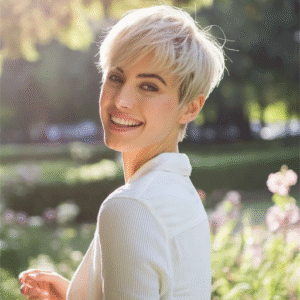Trendy Pixie Cut Ideas for Spring
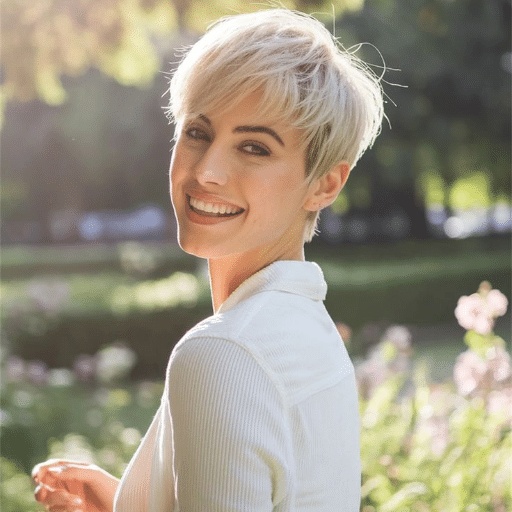
- Textured Pixie with Soft Layers
This look embodies the soft layering concept, creating a foundation for volume and a sense of movement. Therefore, the style is suitable for any hair type. A textured pixie suits both day casual concerts and elegant formal dinner affairs. - Sleek Side-Swept Pixie
For highly polished, chic looks, the side-swept pixie speaks to sleek lines and an obvious parting area from which such hair flows. It pairs best with straight hair, adding great elegance to the face. - Tousled Pixie with Bangs
The messy pixie is an excellent choice for achieving a relaxed yet cool appearance. It generally works well with soft bangs that complement the face. This haircut is especially suited to oval and heart-shaped faces. - Undercut Pixie with Bold Contrast
An undercut pixie involves shaved sides paired with longer layers on top, aiming for texture, and may include some permanent waves unrelated to the underlayer. It’s a pretty confident and very trendy statement.
Classic Pixie: Timeless Elegance
It is a versatile and timeless hairstyle that embodies simplicity with a touch of sophistication. The typical pixie cut features short, even layers that hug the shape of the head, complementing various face shapes, especially those with an oval or square shape. The classic pixie has a timeless appeal, requires very little maintenance, and works well when styled for either casual looks or formal occasions-a quick go-to for an elegant yet easy-minded person.
Edgy Pixie: Bold and Modern
The edgy pixie cut is a significant departure from traditional style, characterized by asymmetrical layers, angled finishes, and heavy texturing. This modern take is for those who want to make a bold and loud statement; alternatively, it incorporates shaved sides, contrasting lengths, or bright colors to create a striking look. Recent data from the Google search engine indicates a surge in searches for edgy pixie cuts over the last few months, particularly accompanied by keywords such as “alternative hairstyles” and “undercut pixie.” Underlying this trend is the rise in demand to express one’s style in terms of creativity and individuality. Perfect for those who wish to maintain their fashion consciousness while boldly standing out as unique and confident.
Curly Pixie: Embrace Your Curls
This curly pixie cut is a versatile and stylish choice that celebrates the natural texture of curls while maintaining a low-maintenance and modern flair. The style works well to showcase volume and definition, thanks to its layers that amplify the bounce and form of curly hair. Typically, maintenance for curly pixie would involve regular trims to keep the shape, along with moisturizing hair care approaches to fight frizz and keep the curl hydrated. Curling creams and lightweight gels are typically suitable for defining and holding curls; diffusing while drying can provide you with much-needed volume. Paired with soft fringe or a bold undercut, the curly pixie offers the perfect blend of practicality and style, highlighting the character of anyone who chooses to showcase their natural curve. Lots of source material point out the value of using sulfate-free products to prevent dryness and ensure long-lasting vibrancy.
Choosing the Right Pixie Haircut for Your Face Shape
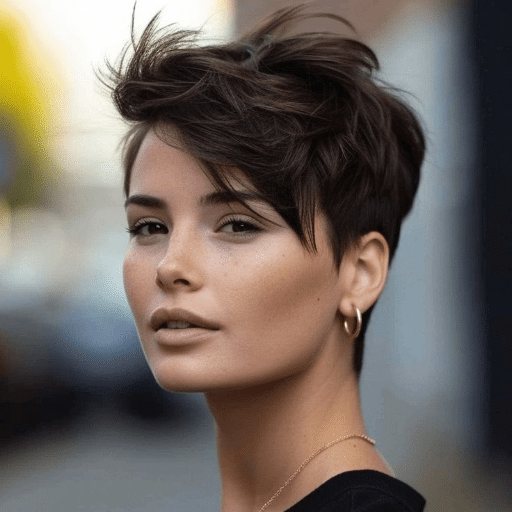
A pixie haircut can maximize your outward appearance when you familiarize yourself with how it complements your facial structure, as many possibilities exist. Pixie cuts for oval faces work well virtually all the time because this specific shape offers a good balance. The Round face needs pixie cuts with height and some asymmetry only to increase angular definitions. Square faces will pair perfectly with softer textures and layers to counterbalance the strong jawline. Therefore, a pixie cut is ideal for a heart-shaped face when it has volume at the crown level. Also, slight side-swept fringes help to counterbalance a broad forehead. For an oblong-shaped face, styling your pixie with bangs can work wonders in making it appear shorter. Identifying your face shape and discussing it with a stylist can be beneficial to ensure that the cut effectively enhances your features.
Determining Your Face Shape
To determine your face shape, start by taking four measurements of your face at specific points using a flexible tape measure or a ruler. First, measure the width of your forehead at its widest point, which is generally halfway between your hairline and eyebrow. Next, measure your cheekbones, across the high area of your cheeks. Then test your jaw, from the base of one ear down to the tip of your chin, and then multiply this by two for the final jaw measurement. Finally, measure the length of your face from the middle of your hairline to the tip of your chin.
Those measurements are compared to discern your face shape. For instance, your face length might far exceed the width when you have an oblong face. In the case of a square versus a round face, both usually measure about the same in length and width, although for a square, the jawline is a little more angular. Heart faces usually measure wide in the forehead and cheekbone area and narrower in the jawline and chin. By accurately identifying these proportions, you will gain a better understanding of your face shape and be able to complement it with a suitable hairstyle or makeup technique.
Best Pixie Cuts for Different Face Shapes
An ideal pixie cut, depending on the face shape, can accentuate one’s features and create a balanced and elegant silhouette. Below is a short guide for picking a pixie cut that flatters your face more:
| Face Shape | Recommended Pixie Style | Key Features |
|---|---|---|
| Oval Face | Traditional cropped pixie with textured layers or straight, side-parted pixie | Ample volume above the head complements natural symmetry |
| Round Face | Pixies with height and angular elements | Asymmetric bangs, long layers on top, shaved sides or undercuts for contour |
| Square Face | Soft, choppy layers with side-swept bangs | Feathered edges to soften strong angles and frame jawline |
| Heart-Shaped Face | Tapered pixie with volume at crown | Longer, side-swept bangs to balance wider forehead and narrower chin |
| Oblong Face | Pixie with even volume and soft bangs | Short, soft bangs to reduce perceived length and maintain balance |
The best results will come from working with a stylist who has experience working with a variety of face shapes and hair textures. A personalized pixie cut will surely bring out the best in your natural beauty.
How Hair Type Influences Your Pixie Cut
Hair type determines, above all else, the style and suitability of your alternative pixie cut. For instance, with fine hair, layers create the illusion of volume and texture, so it looks fuller. For thick hair, thinning and undercutting may reduce the bulk of the hair and its manageability. Although long pixie cuts work well for curly and wavy hair because the texture itself adds movement and dimension, pixie cuts for straight hair are clean and modern, featuring sharp-edged definition that is all about the structure. A well-trained stylist working with diverse hair types ensures that your pixie cut is well-suited to your face shape and hair nature, resulting in a polished, harmonious effect.
Hair Color Trends for Pixie Haircuts in 2025

Entering 2025, the hair colors for pixie haircuts emphasize creativity and individuality in their shades, bold or subtle. Muted pastel hair shades, such as sage green, lavender, and soft peach, are set to take center stage due to their subtle pairing with the clean lines of the pixie cut. Platinum and jet black will never perish as classic options if a person really desires some dramatic contrasts. Balayage and color blocking shall be one of the techniques widely used because they allow for comparison and dimension in a shorter hair style without demanding much maintenance. For a more modern look, consider metallic finishes and iridescent colors, which sparkle with light and accentuate the biker style.
Spring-Inspired Hair Color Ideas
For a spring look, pastel hues remain the top choice, bringing in the soft and whimsical charm. Colors such as lavender, peach, and mint green are in line with the delicate aesthetics the season brings and, more importantly, these colors also sit beautifully over most skin tones. Warm blondes with golden undertones may also be great options, such as those of honey or butterscotch, evoking the warm glow of spring sunshine. On the bolder side, colors like strawberry red and coral make quite the statement and thus would be an apt choice for such an energetic season. Combining these colors with subtle highlights or an ombre effect would provide a smooth transition into spring.
Pastel and Bold Colors: Making a Statement
These pastel and bold hues make a striking expression of individuality and creativity. According to experts, pastel shades, including lavender, blush pink, and baby blue, evoke a soft and ethereal look, whereas bold colors like electric blue, fiery orange, and emerald green grab attention and convey intense confidence. These colors look best when custom-tailored to suit their wearer’s skin undertone and styled with coloring techniques like balayage or loud full-coverage applications. Maintaining these colors is demanding; special shampoos for color protection and frequent touch-ups will work wonders for ensuring that the colors stay theirs and remain vivid. With the right color and the proper maintenance, pastel and bold colors make a real statement.
Blending Techniques for a Chic Look
A chic style with a pixie cut appears to be much more about the blend technique to ensure a smooth finish with a polishing effect. The main procedures are point cutting and feathering cuts, which soften the transition in length and add texturing to avoid stark lines. It then usually utilizes an element of razor cutting or adroit use of texturizing shears just to maintain that lovely texture, giving the cut a more drifting and contemporary feel.
To perfectly frame the face, the hair must be tapered down the sides and at the back. A gradual fade, on the other hand, can be achieved for a more mature, clean finish, whereas soft layers on top add height and depth. The stylist will subtly reduce bulk in certain areas to accentuate the shape of the cut using the method above, particularly for coarser hair types. Whereas it is at those interfaces that blending is of paramount importance to maintain style or avoid imbalance.
It’s best to use light styling products when finishing with texture sprays or pomades, as they work perfectly to give some definition while still allowing the hair to feel light. The aim is to retain the shape of the cut, with the added benefit of being able to style it in various ways. Getting the blend down will take your cut from refined to distinct.
Maintaining Your Pixie Haircut
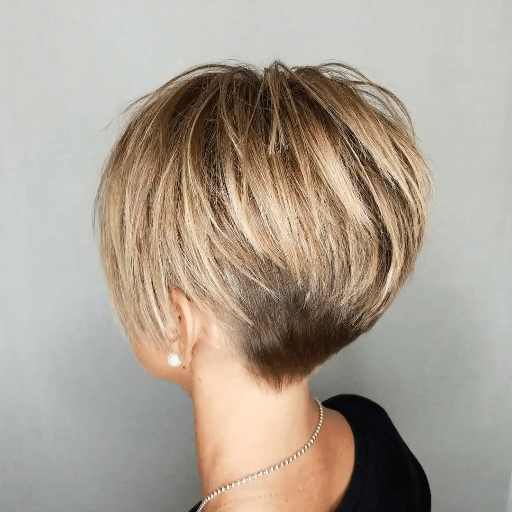
Your pixie cut requires trimming every 4-6 weeks to maintain its shape and structure. For healthy hair, use a sulfate-free shampoo to prevent it from drying out. Afterward, apply a lightweight conditioner to keep your hair manageable. Regularly apply styling products such as texturizers for greater definition while maintaining the hair’s natural equilibrium and avoiding product overload. Always use a heat protectant before working with heat tools and continue to use it afterward for longevity and to minimize damage.
Keeping Your Pixie Fresh: Trim Schedules
Trimming keeps the shape and structure of a pixie cut sharp, which is necessary if you want it to stay true to its original intent. An average stylist will recommend going in every 4 to 6 weeks for a trim. This time period is ideal for approximately half an inch of hair growth per month, allowing the style to remain nice and well-proportioned. Waiting longer may result in a less uniform appearance, making it more challenging to style well. Sticking to this general mold will keep your pixie looking crisp and polished, and it will also benefit your hair’s health by reducing split ends and promoting even hair growth.
Common Mistakes to Avoid with Pixie Cuts
- Neglecting Maintenance Trim
In my experience, going for long periods without trims will cause your pixie cut to lose its contours quickly. One must keep visiting a stylist for trim work in every four to six weeks. - Choosing the Wrong Cut for Your Face Shape
Way back when I had my pixie cut, I really began to understand how important it is to choose a style that suits one’s face shape. Not all pixies suit all faces, so consulting with a hairstylist to find the one that is most flattering for you is a must. - Too Much Product, Please
The more product you apply, the more it weighs down your hair and makes it greasy or flat looking. What I’ve found works best is just a tiny bit of lightweight product such as mousse or pomade that gives definition but doesn’t drown the hair. - Neglecting Scalp Care
Since pixie cuts reveal so much more of the scalp, I make a point to give my scalp attention, having it cleansed and hydrated regularly to avoid dryness and flakiness that can become so apparent. - Avoiding Experimentation
I used to shy away from experimenting with my pixie cut, but it’s really one of those styles that probably won’t let you down! Mixing things up with accessories, parting, or new styling techniques can only keep things fresh and fun.
Personalizing Your Pixie Cut
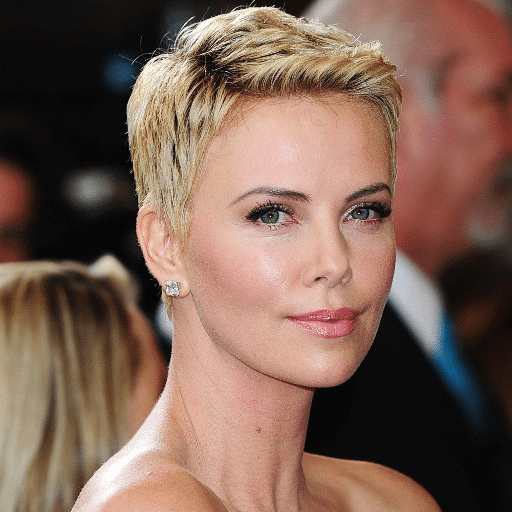
The personalization of your pixie cut begins with analyzing your face shape, hair texture, and personal preference. Layers or asymmetry are often added to bring movement and dimension, while specific hair length by the ears or bangs may draw attention to your favorite features. Play around with a styling product from texturizing spray to a pomade, finishing anywhere from sleek and glossy to messy and funky. Accessories like headbands or clips can instantly refresh your look. A consultation with an experienced stylist for adjustments unimaginable will help your pixie work seamlessly with the entire look.
Expert Tips from Hairstylists
- Styling With Proper Tools
Professional stylists emphasize the importance of high-quality tools specific to your hair needs. For pixie cuts, small flat irons or curling wands help to smooth or texture, creating finishes that are as desired. Blow-drying with a concentrator nozzle is paramount to direct shaping and volume control. - Products Must Be Chosen Based on Hair Texture
Use products that are appropriate for your hair texture. Lightweight products are best for fine hair, such as volumizing sprays or mousses, as they will not weigh the hair down. For thicker types of hair, hardening creams and oils work well to keep the hair smooth and fight frizz. - Maintain the Style in Your Routine
Pixie cuts must be trimmed every four to six weeks to maintain their shape and structure. Stylists recommend pre-scheduled appointments to keep edges sharp and layers balanced, ensuring they work with your outline structure over time.
Accessorizing Your Pixie for Spring
The best way to accessorize a pixie cut for spring is to keep options light and versatile, so that the look is enhanced rather than overpowered. For added play, colorful clips or small barrettes to pin back sections of hair are always fun to tie into seasonal trends. Another favorite, padded or fabric headbands add some great dimension while keeping things fresh and polished. On breezy spring days, keep it chic and functional with delicate scarves tied as a headband or woven into the hair. It offers excellent contrast to the structure and layers of a pixie cut and is a great way to serendipitously mix up the look with minimal effort.
Textures and Layers: Adding Dimension
The namesake for any dimension in the pixie is textures and layers. Texturizing techniques, such as point cutting or razor cutting, blur the edges, making them less hard-edged or flat due to a more gradual line of cutting. Layers allow movement and fullness into this process, of particular importance for a thin hair type as making it current but not dead flat. Styling products for texture and maintaining movement include texturizing sprays and lightweight mousses, as well as tools that allow for gentle waving or flicking straight along flat irons or curling wands. By using texture and layers, the pixie can be adapted to fit any face shape, creating a look that is evenly weighted and immensely fun to wear.
Reference Sources
- Pixie Cut Hairstyle Ideas 2025 – Cosmopolitan
- 70 Pixie Haircuts for Women Seeking Stylish Looks in 2025 – The Right Hairstyles
- Pixie Haircut Inspiration And Styling Tips For 2025 – Elle
- 63 Stunning Short Hairstyles To Try In 2025 – Southern Living
- 55 Pixie Cuts That Will Inspire You to Go Short – Good Housekeeping
Frequently Asked Questions (FAQs)
What are the different types of pixie cuts?
How to Choose a Pixie Cut for Round Faces?
What’s the best way to style a wavy pixie?
How can one get a modern pixie cut?
What hair colors go well with pixie hairstyles?
Pixie hairstyles can be styled with a variety of hair colors. Shades like platinum, blonde, and pastel pink can create dramatic effects. A darker shade, on the contrary, would run more towards klassic. Consider a color that complements your skin tone and makes the pixie haircut really stand out.

